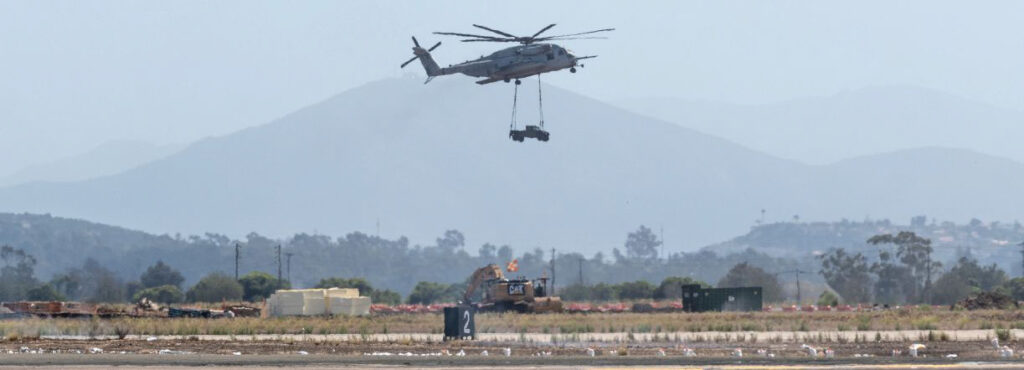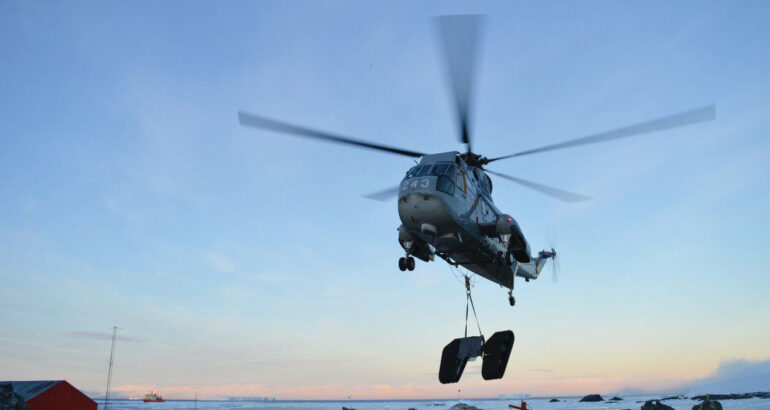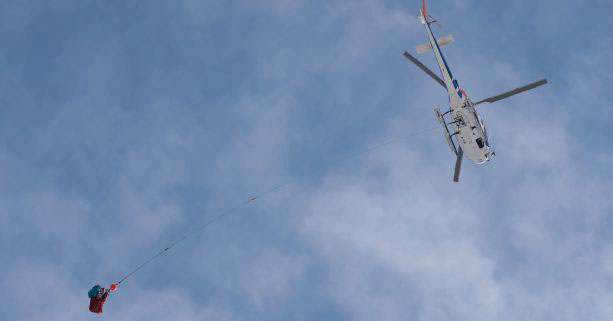Prior to the start of any operation involving the use of a helicopter, a thorough survey of the conditions and hazards on the job site shall be made by the employer in conjunction with the pilot or pilot’s representative to ensure a safe operation.
A Code of Safe Practices shall be formulated and enforced for operations involving the use of a helicopter.
A daily briefing shall be conducted prior to starting work to set forth the plan of operation for that day. This briefing shall include planning to minimize possible hazards of the day’s operation and all personnel exposed shall be informed and directed as to safeguards and escape procedures.
If the helicopter pilot in command believes—for any reason—that a lift or operation cannot be performed safely, then that lift or operation shall not be attempted.
Helicopter operations shall not be performed beyond the helicopter ’s approved external load capacity or pilot’s certification. The pilot’s employer shall ascertain before operations begin that the pilot is properly certificated by the FAA and qualified to perform the planned operations.
GENERAL RULE
1. Helicopter cranes shall comply with regulations of the Federal Aviation Administration (FAA).
2. Before each day’s operation, a briefing shall be conducted to set forth the plan of operation for the pilot and ground personnel.
3. Loads shall be properly slung.
a. Tag lines shall be of a length that will not permit their being drawn up into rotors.
b. Pressed sleeve, swedged eyes, or equivalent means shall be used for all freely suspended loads to prevent hand splices from spinning open or cable clamps from loosening.
4. All electrically operated cargo hooks shall have the electrical activating device so designed and installed as to prevent inadvertent operation.
a. In addition, these cargo hooks shall be equipped with an emergency mechanical control for releasing the load.
b. The hooks shall be tested prior to each day’s operation to determine that the release functions properly, both electrically and mechanically.
5. PPE equipment for employees receiving the load shall consist of eye protection and hard hats secured by chinstraps.
6. Loose-fitting clothing likely to flap in the downwash, and thus be snagged on the hoist line, shall not be worn.
7. Every practical precaution shall be taken to provide for the protection of the employees from flying objects in the rotor downwash. All loose gear within 100 ft (30.4 m) of the place of lifting or depositing the load, and all other areas susceptible to rotor downwash, shall be secured or removed.
8. The helicopter pilot shall be responsible for the size, weight, and manner in which loads are connected to the helicopter. If, for any reason, the helicopter pilot believes the lift cannot be made safely, the lift shall not be made.
9. When employees are required to work under hovering craft, safe access shall be provided for employees to reach the hoist line hook and engage or disengage cargo slings. Employees shall not work under hovering craft except to hook, unhook, or position loads.
10. Static charge on the suspended load shall be dissipated with a grounding device before ground personnel touch the suspended load, or protective rubber gloves shall be worn by all ground personnel touching the suspended load.
11. The weight of an external load shall not exceed the rated capacity.
12. Hoist wires or other gear, except for pulling lines or conductors that are allowed to “pay out” from a container or roll off a reel, shall not be attached to any fixed ground structure or be allowed to foul on any fixed structures.
13. When visibility is reduced by dust or other conditions, ground personnel shall exercise special caution to keep clear of main and stabilizing rotors. Precautions shall also be taken to eliminate reduced visibility.
14. No unauthorized person shall be allowed to approach within 50 ft (15.2 m) of the helicopter when the rotor blades are turning.
15. Whenever approaching or leaving a helicopter with blades rotating, all employees shall remain in full view of the pilot and keep in a crouched position.
16. Employees shall avoid the area from the cockpit or cabin rearward unless authorized by the helicopter pilot to work there.
17. There shall be constant reliable communication between the pilot and a designated employee of the ground crew who acts as a signal person during loading and unloading. This signal person shall be distinctly recognizable from other round personnel.
18. Good housekeeping shall be maintained in all helicopter loading and unloading areas.
LANDING OPERATIONS
a. Landing and hovering sites shall be chosen with approval of the pilot or pilot’s representative.
b. All such sites shall have at least a 200-foot diameter area clear of all loose materials and objects which could be hazardous if displaced by rotor downwash. The helicopter shall be required to deposit or lift loads in the center of the approved area.
c. Precautions shall be taken by the employer to eliminate as far as practical reduced visibility.
d. Access and egress to the helicopter shall be from the front and along the same level or to a level lower than the helicopter. No one shall be permitted to approach or leave the helicopter while the engine is running or the rotor is turning without a permissive signal or instruction from the pilot or pilot’s designee.
e. Built-up landing sites shall be capable of supporting a helicopter on any single square foot of the landing surface and provide good footing.
f. Prepared landing sites on hillsides shall be no less than 12 feet by 12 feet and shall be large enough to land the helicopter so that the largest rotor clears the hillside by a distance equal to its radius measured horizontally from the tip of the rotor. (Exception: In an emergency, a helicopter may land wherever possible.)
STATIC ELECTRICITY
An effective method of protecting workers from static electrical discharge shall be provided.
FUELING
a. The engines and radio transmitters shall be shut off, and smoking, open flame or other source of ignition shall not be permitted within 50 feet of fueling operations or fuel storage areas. (Exception for FAA approved alternate fueling methods or closed-circuit hot refueling.)
b. The helicopter and fuel supply shall be securely bonded and grounded before and during fueling operations for static electrical discharge.
c. There shall be two 60B:C rated fire extinguishers or equivalent fire fighting protection at each fueling station attended by ground crews.
COMMUNICATIONS
a. During helicopter operations, the pilot shall be notified at least 30 minutes prior to any blasting operation on the project and also after each blast to signify the all-clear condition.
b. The pilot shall be informed by the person in charge of the project of the erection of any newly suspended line or other navigational hazard on the project or in the area of helicopter operations.
c. Signal systems between air crew and ground personnel shall be understood and checked in advance of hoisting the load.
d. The pilot shall receive signals from only one signal person who is distinguishable from the rest of the crew.
GROUND CREW
a. All ground crew members shall be thoroughly instructed by the pilot or pilot’s representative in their duties and of the immediate hazards. Escape procedures shall be planned with the pilot or pilot’s representative in event of helicopter failure. b. Ground crew members shall wear dust goggles for eye protection and approved head protection with chin straps in place. Ear protection and dust protection where required shall be in accordance with applicable safety orders.
c. Only those persons associated with the helicopter operations shall be permitted to approach within 50 feet of the operating helicopter.

CARGO LOADING AND HANDLING
a. All cargo shall be loaded and secured under the direction of the pilot or pilot’s designee.
b. No passenger shall be transported in the helicopter with a sling load and no person shall be transported as an external or sling load, except in an emergency. (Exception: Unless authorized by the FAA.)
c. Explosives and other “dangerous materials” shall not be transported except as authorized by FAA.
d. All sling loads, including line stringing devices, shall be attached only to quick-release devices. Steel or metallic sling ends shall be of the pressed sleeve or swedged eyetype, or equivalent. Tag lines shall be of a length or secured in such a manner that will not allow their being drawn up into the rotors.
e. Automatic release devices are prohibited in all construction operations where ground crews are used. The devices shall be activated only for actual placement of loads. Electrical release devices shall have mechanical back-up, be checked each day of operation, and be designed to prevent inadvertent operation.
f. When stringing conductive lines or conductors, there shall be radio communication between the helicopter and the ground crew.
g. When stringing lines or conductors close to or parallel to energized lines, conductive lines or reels, pay-out machines, and conductors shall be grounded as required by the High Voltage Electrical Safety Orders. Hoist wires or other gear shall not be attached to any fixed ground structure. (Exception: when pulling lines or conductors that are allowed to “pay-out” from a container or roll off a reel.)
h. External sling load operations shall not be performed if electrical storms in the immediate vicinity make the work unsafe.
i. Load landing operations shall not be performed when the wind conditions are deemed too unsafe by the pilot or ground crew.
j. There shall be a minimum clearance of at least 25 feet between any energized power line, rated 50 KV or below, and any part of the rotorcraft load combination. This clearance requirement shall increase at the rate of 1/2 inch for each 1 KV. (Exception: Minimum clearances shall not apply to helicopters or their external loads specifically utilized for power line construction, maintenance, and repair where the work in progress is under the direct supervision of the utility.)
EXPOSED LOCATIONS
a. While working at the edge of or on a steep slope, members of ground crews shall be protected from falling by:
1. A barrier of adequate design to restrain a falling person or;
2. A safety belt with a quick-release buckle and a life line at least 50 feet long.
a. Where practicable when using safety belts, the area shall be cleared of objects which might snag the life lines in an escape procedure.
b. Workers receiving materials while on a towertype structure shall not be positioned in a place of unnecessary exposure and shall be secured to the structure by safety belts or other equivalent
c. Ground crews on elevated surfaces more than 7½ feet high, shall be protected against being swept off by rotor downwash.










